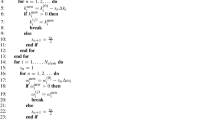Abstract
Prior work has demonstrated the effectiveness of using two-equation closures as the basis for universal, self-adapting turbulence models that are effective at any mesh resolution (Perot and Gadebusch in Phys. Fluids 19:115105, 2007). In order to demonstrate the broad applicability of the fundamental approach, the same behavior is now demonstrated for a second-moment closure (SMC). The SMC has the advantage over the earlier two-equation universal closure of being more accurate in the coarse mesh limit and of having a natural mechanism for backscattering energy from the modeled to the resolved turbulent fluctuations. The mathematical explanation for why Reynolds averaged (RANS) transport equation closures are applicable at any mesh resolution, including the large eddy simulation (LES) regime, is reviewed. It is demonstrated that for the problem of isotropic decaying turbulence, the SMC model produces good predictions at any mesh resolution and with arbitrary initial conditions. In addition, it is shown that the proposed model automatically adapts to the mesh resolution provided. The self-adaptive nature of the method is clearly observed when different initial conditions are used. It is shown that classic RANS models (often thought to produce steady and smooth solutions) can produce three-dimensional, unsteady, and chaotic solutions when generalized correctly and when provided with sufficient mesh resolution. The implications of these observations on the fundamental theories of RANS and LES turbulence modeling are discussed.
Similar content being viewed by others
References
Perot J.B., Gadebusch J.: A self-adapting turbulence model for flow simulation at any mesh resolution. Phys. Fluids 19, 115105 (2007)
Carati D., Ghosal S., Moin P.: On the representation of backscatter in dynamic localization models. Phys. Fluids 7, 606 (1995)
Meneveau C., Lund T.S.: The dynamic Smagorinsky model and scale-dependent coefficients in the viscous range of turbulence. Phys. Fluids 9, 3932 (1997)
Spalart, P., Jou, W., Strelets, M., Allmaras, S.: Comments on the feasibility of LES for wings, and on a hybrid RANS/LES approach. Advances in DNS/LES. Greydon Press, Columbus, p 137 (1998)
Menter, F.R., Kuntz, M., Bender, R.: A scale-adaptive simulation model for turbulent flow predictions. In: ASME Wind Energy Symposium, 41st AIAA Aerospace Meeting, Reston VA, AIAA 2003-767 (2003)
Davidson, L.: Evaluation of the SST-SAS model: channel flow, asymmetric diffuser and axisymmetric hill. In: Wesseling, P., Onate, E., Periaux, J. (eds.) ECCOMAS CFD 2006
Speziale C.G.: Turbulence modeling for time-dependent RANS and VLES: a review. AIAA J. 36, 173 (1998)
Girimaji S., Sreenivasan R., Jeong E.: Partially averaged Navier–Stokes method for turbulence: fixed point analysis and comparison with unsteady partially averaged Navier–Stokes. ASME J. Appl. Mech. 73, 422 (2003)
Deardorff J.W.: The use of subgrid transport equations in a three-dimensional model of atmospheric turbulence. Trans. ASME J. Fluids Eng. 95, 429 (1973)
Schumann U.: Subgrid scale model for finite difference simulations of turbulent flows in plane channels and annuli. J. Comput. Phys. 18, 376 (1975)
Ghosal S., Lund T.S., Moin P., Akselvoll K.: A dynamic localization model for large-eddy simulation of turbulent flows. J. Fluid Mech. 286, 229 (1995)
Germano M.: Turbulence: the filtering approach. J. Fluid Mech. 238, 325 (1992)
Jones W.P., Launder B.E.: The prediction of laminarization with a two-equation model of turbulence. Int. J. Heat Mass Transf. 15, 301 (1972)
Wilcox D.C.: Turbulence modeling for CFD. DCW Industries, La Canada (1993)
Perot, J.B., de Bruyn Kops, S.: Modeling turbulent dissipation at low and moderate Reynolds numbers. J. Turbul. 7 (2006)
Smith, B.R.: A near wall model for the k-l two equation turbulence model. AIAA 94–2386 (1994)
Perot, J.B.: Turbulence modeling using body force potentials. Phys. Fluids 11 (9), (1999)
Durbin P.A.: A Reynolds stress model for near-wall turbulence. J. Fluid Mech. 249, 465–498 (1993)
Rotta J.C.: Statistische theorie nichthomogener turbulenz. Z.Phys. 129, 547 (1951)
Perot J.B., Natu S.: A model for the dissipation tensor in inhomogeneous and anisotropic turbulence. Phys. Fluids 16(11), 4053 (2004)
Harlow F.H., Welch J.E.: Numerical calculation of time dependent viscous incompressible flow of fluid with free surface. Phys. Fluids 8, 2182 (1965)
Chang W., Giraldo F., Perot J.B.: Analysis of an exact fractional step method. J. Comput. Phys. 180, 183 (2002)
de Bruyn Kops S.M., Riley J.J., Kos’aly G.: Direct numerical simulation of reacting scalar mixing layers. Phys. Fluids 13(5), 1450 (2001)
Perot J.B.: Conservation properties of unstructured staggered mesh schemes. J. Comput. Phys. 159(1), 58 (2000)
Perot J.B., Nallapati R.: A moving unstructured staggered mesh method for the simulation of incompressible free-surface flows. J. Comput. Phys. 184, 192 (2003)
de Bruyn Kops S.M., Riley J.J.: Direct numerical simulation of laboratory experiments in isotropic turbulence. Phys. Fluids 10(9), 2125 (1998)
Comte-Bellot G., Corrsin S.: Simple Eulerian time correlation of full and narrow-band velocity signals in grid-generated isotropic turbulence. J. Fluid Mech. 48, 273 (1971)
Gadebusch, J.: On the development of self-adapting (RAN/LES) turbulence models for fluid simulation at any mesh resolution. Dissertation, University of Massachusetts, Amherst (2007)
Author information
Authors and Affiliations
Corresponding author
Additional information
Communicated by M. Y. Hussaini
Rights and permissions
About this article
Cite this article
Perot, J.B., Gadebusch, J. A stress transport equation model for simulating turbulence at any mesh resolution. Theor. Comput. Fluid Dyn. 23, 271–286 (2009). https://doi.org/10.1007/s00162-009-0113-x
Received:
Accepted:
Published:
Issue Date:
DOI: https://doi.org/10.1007/s00162-009-0113-x




